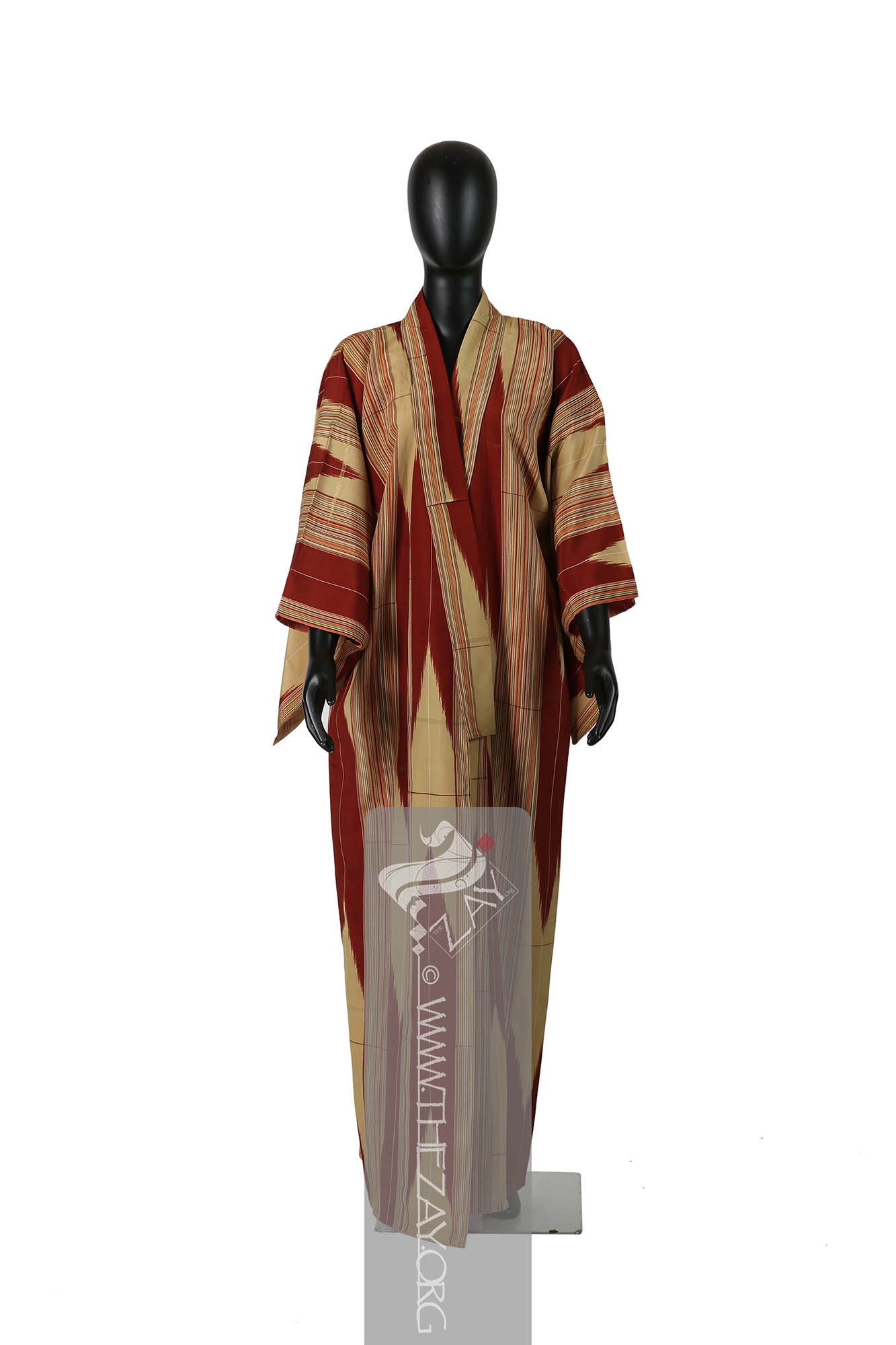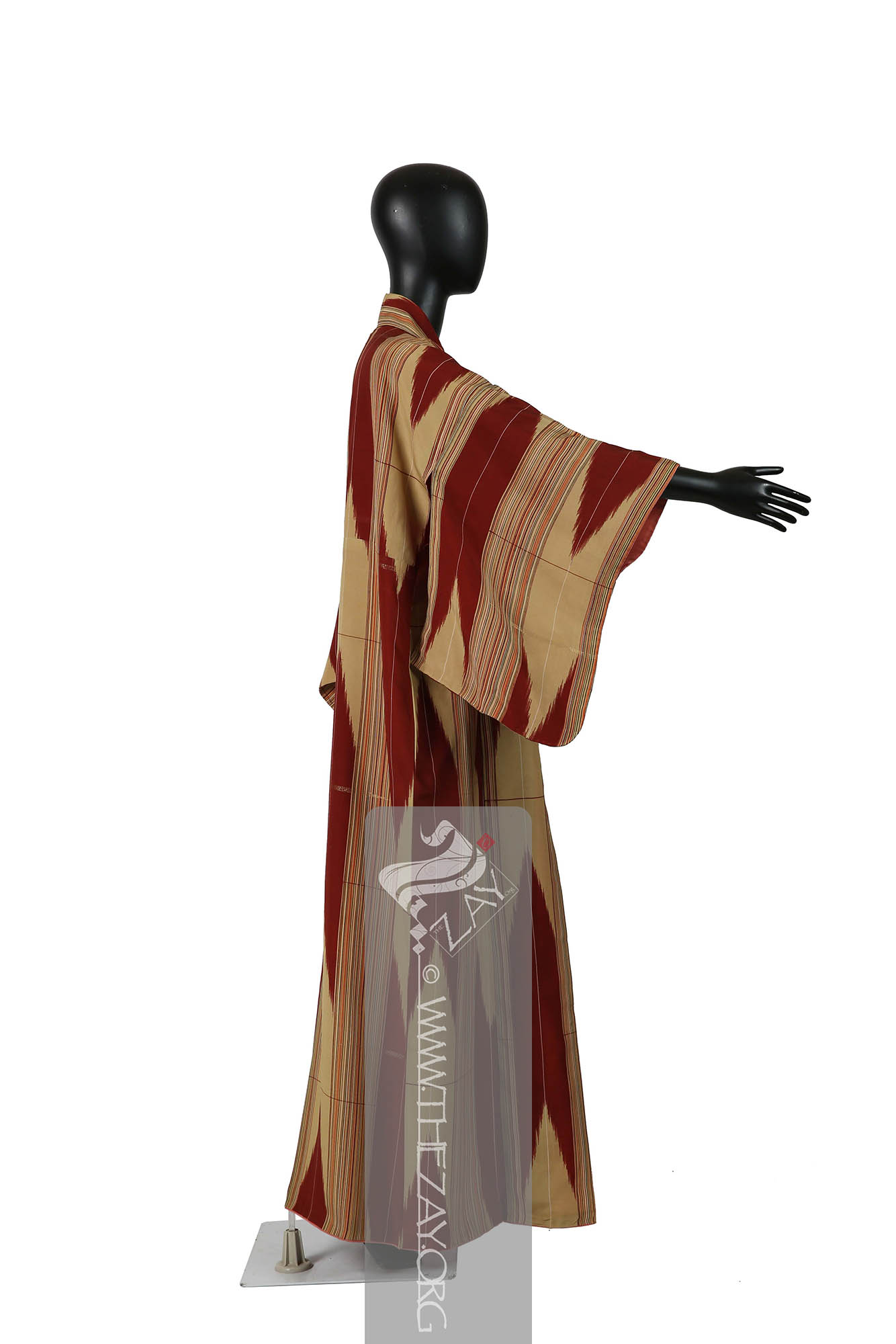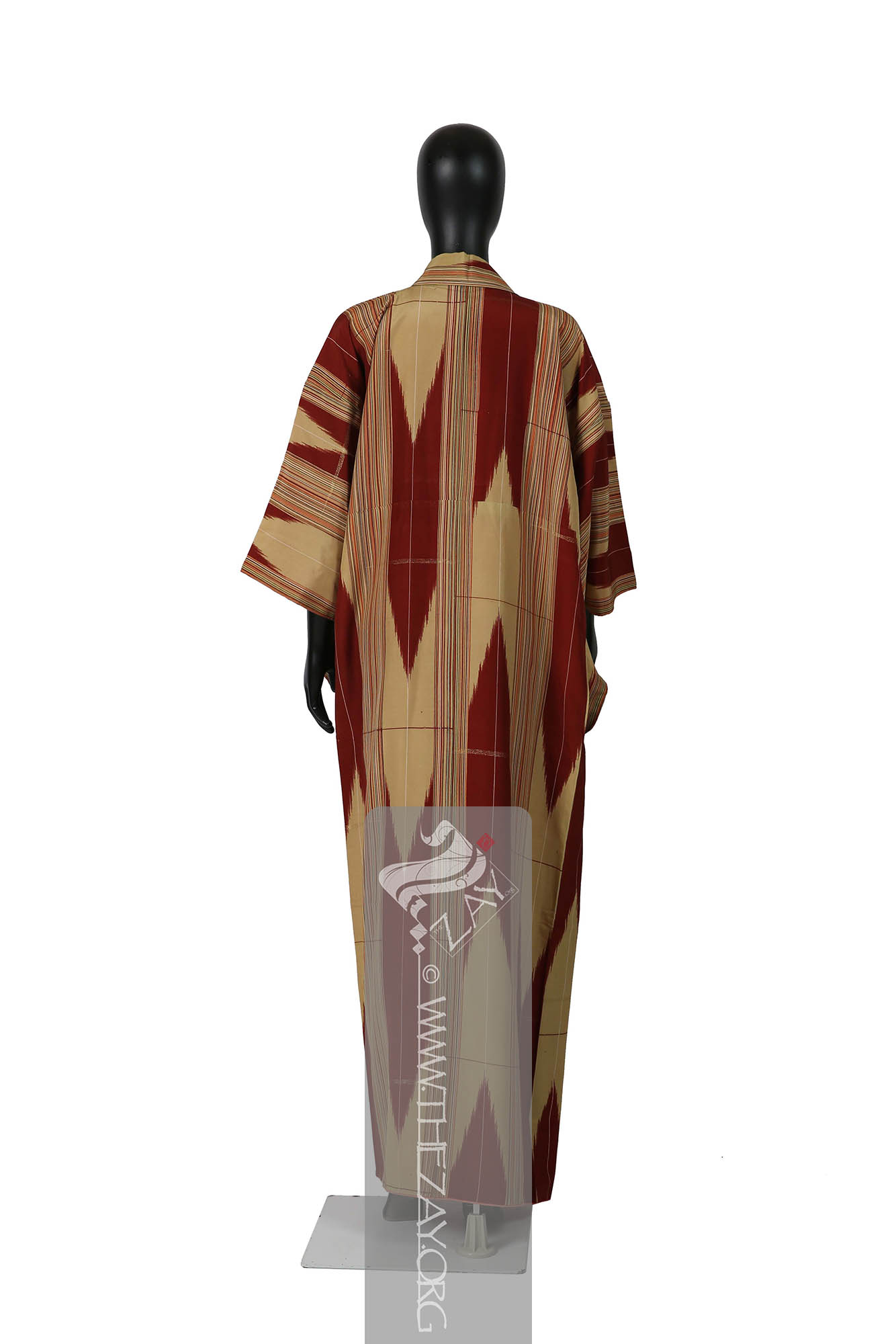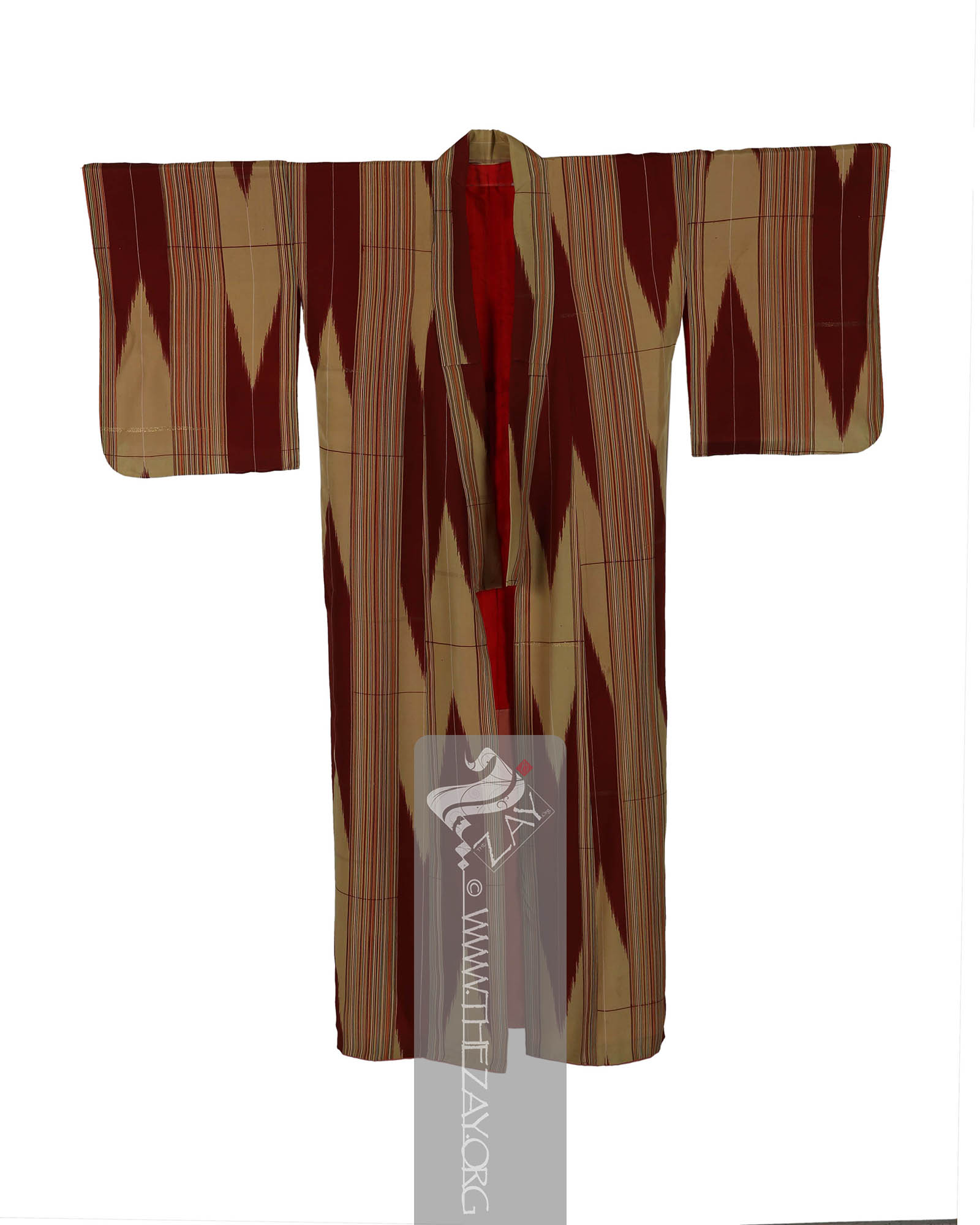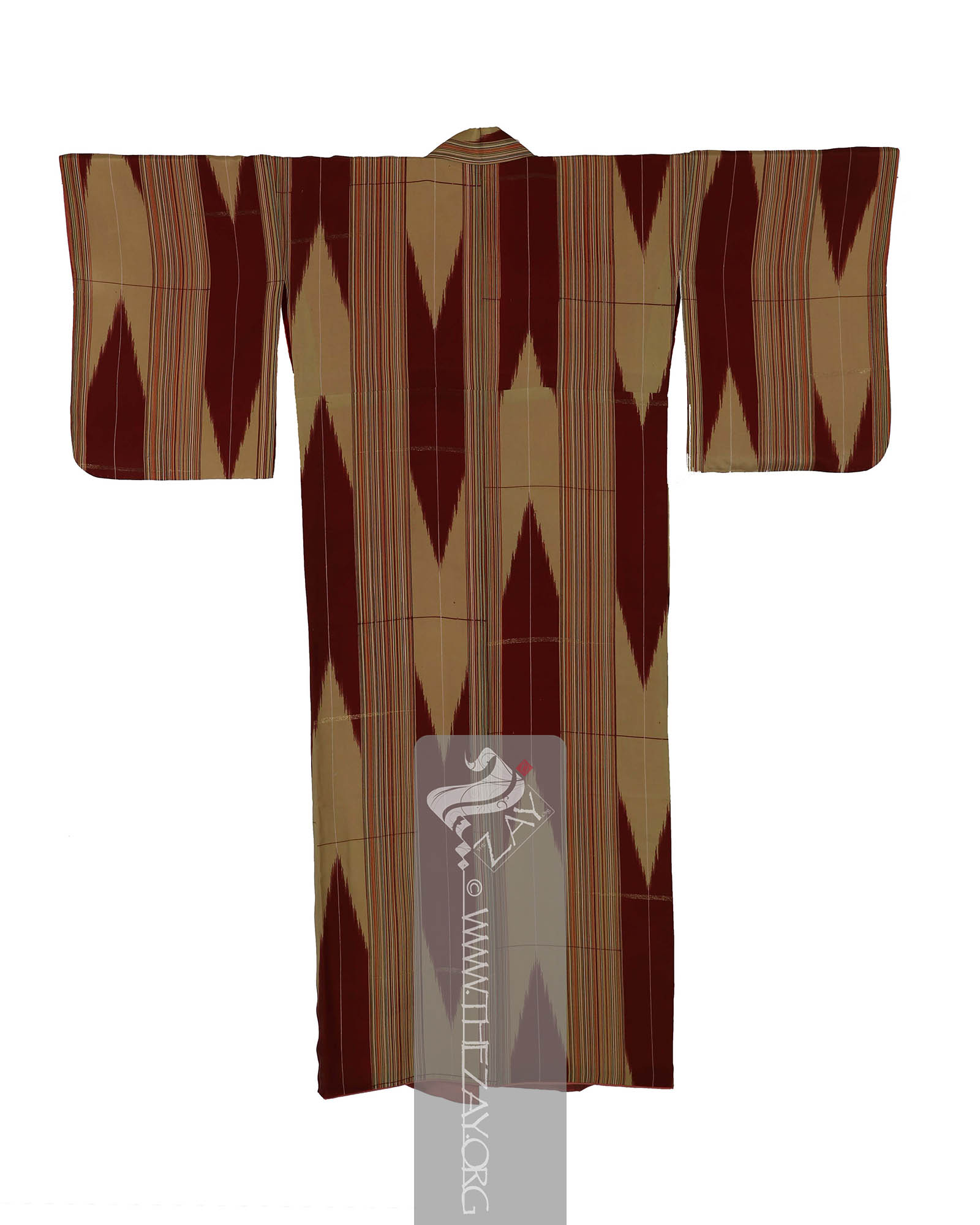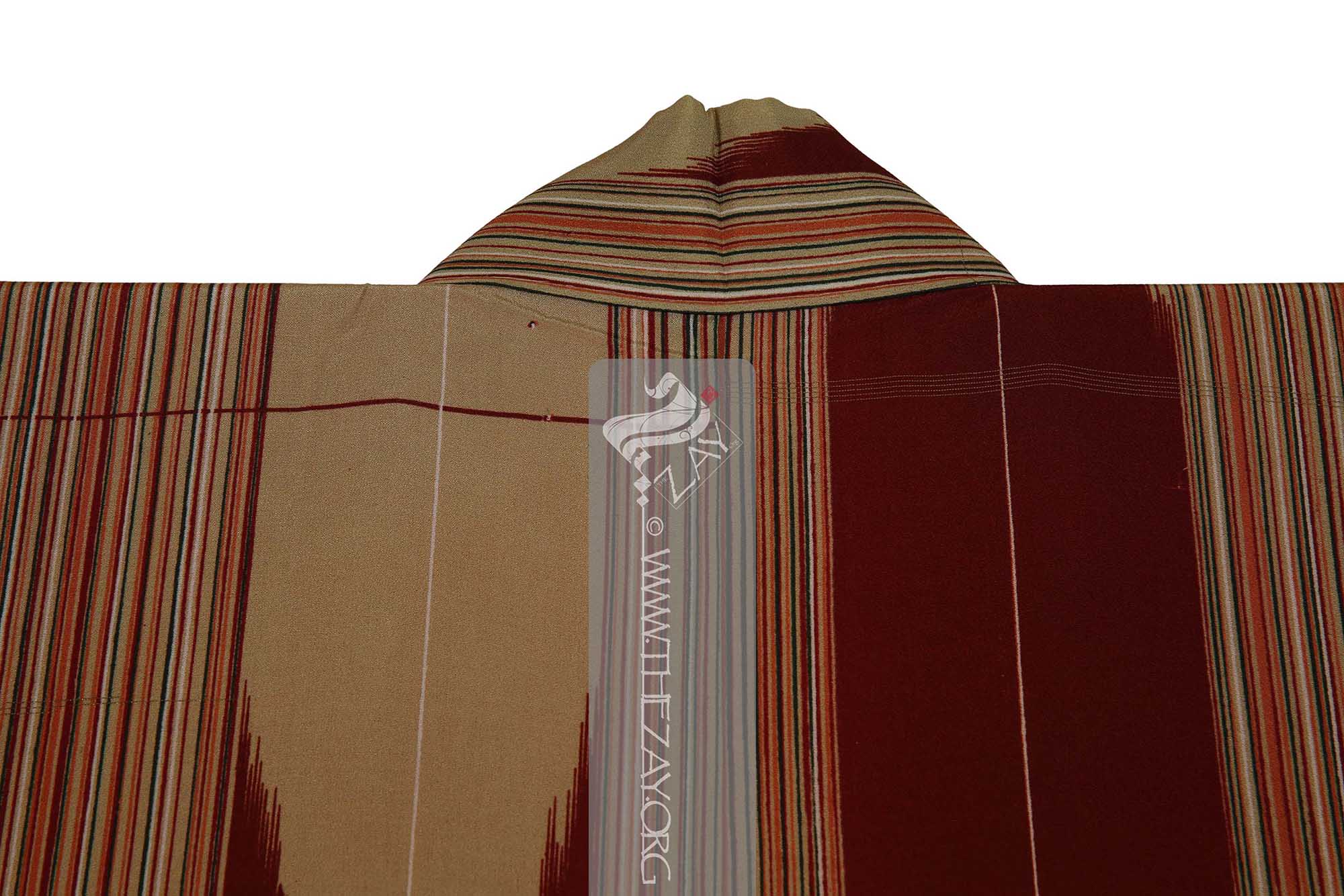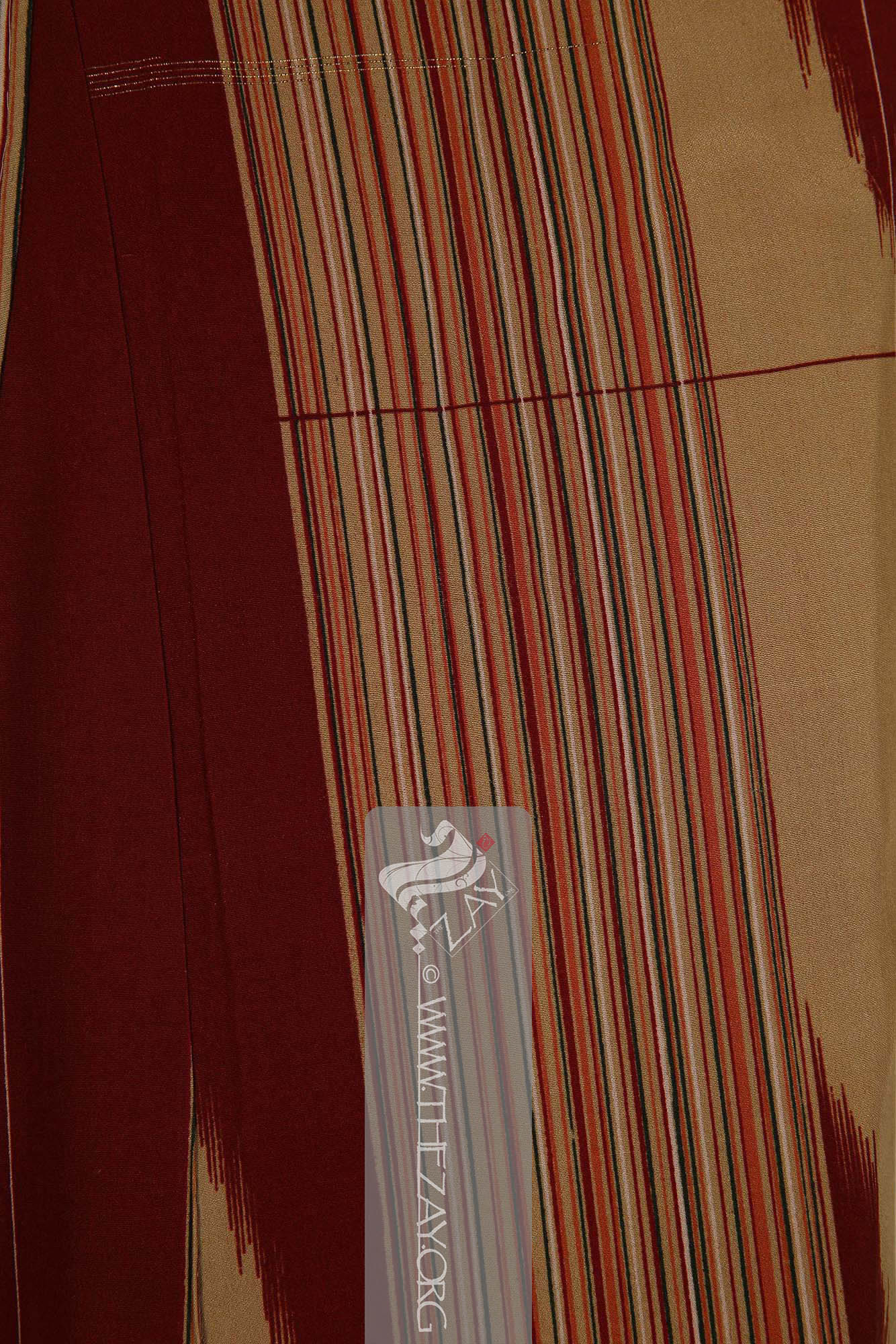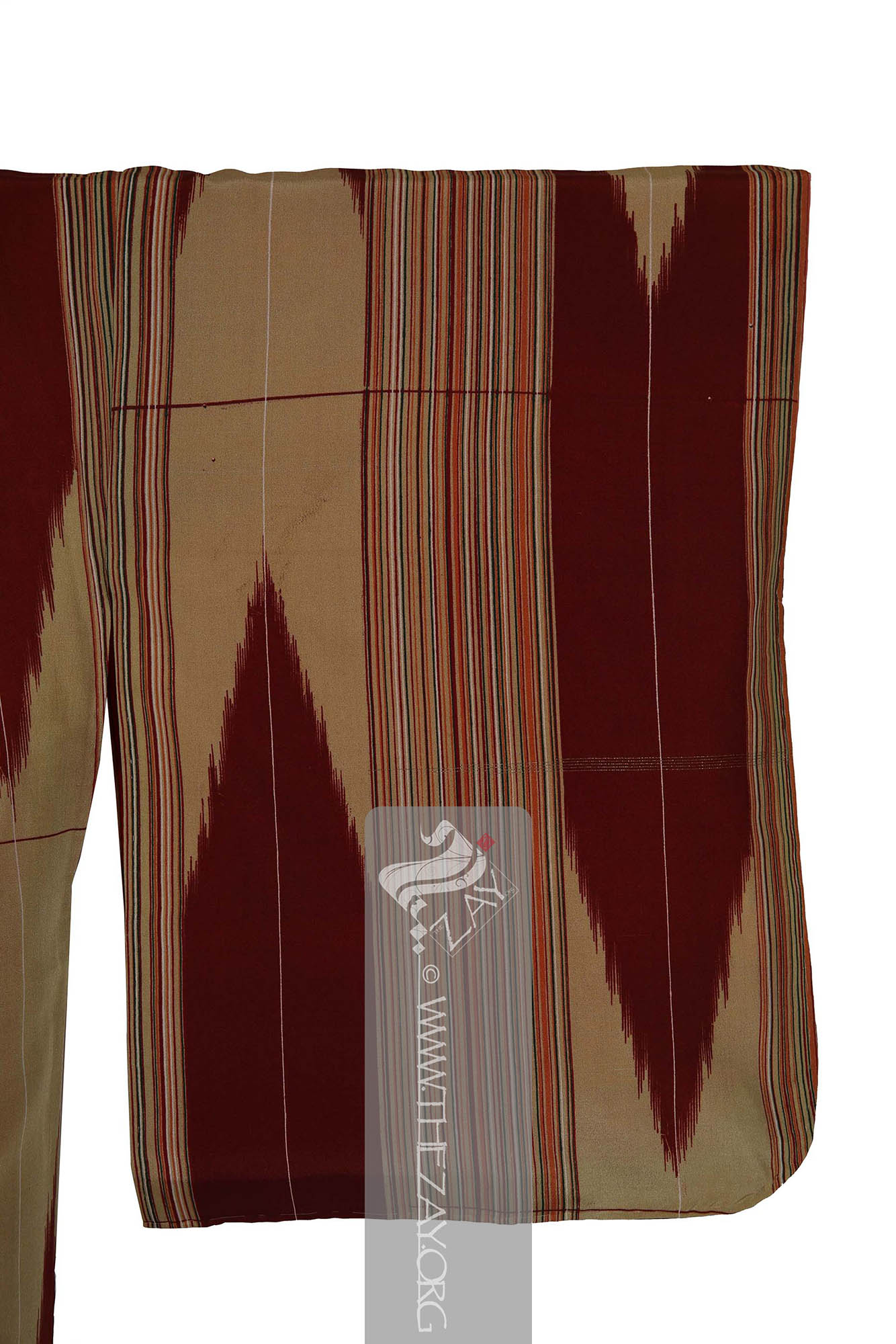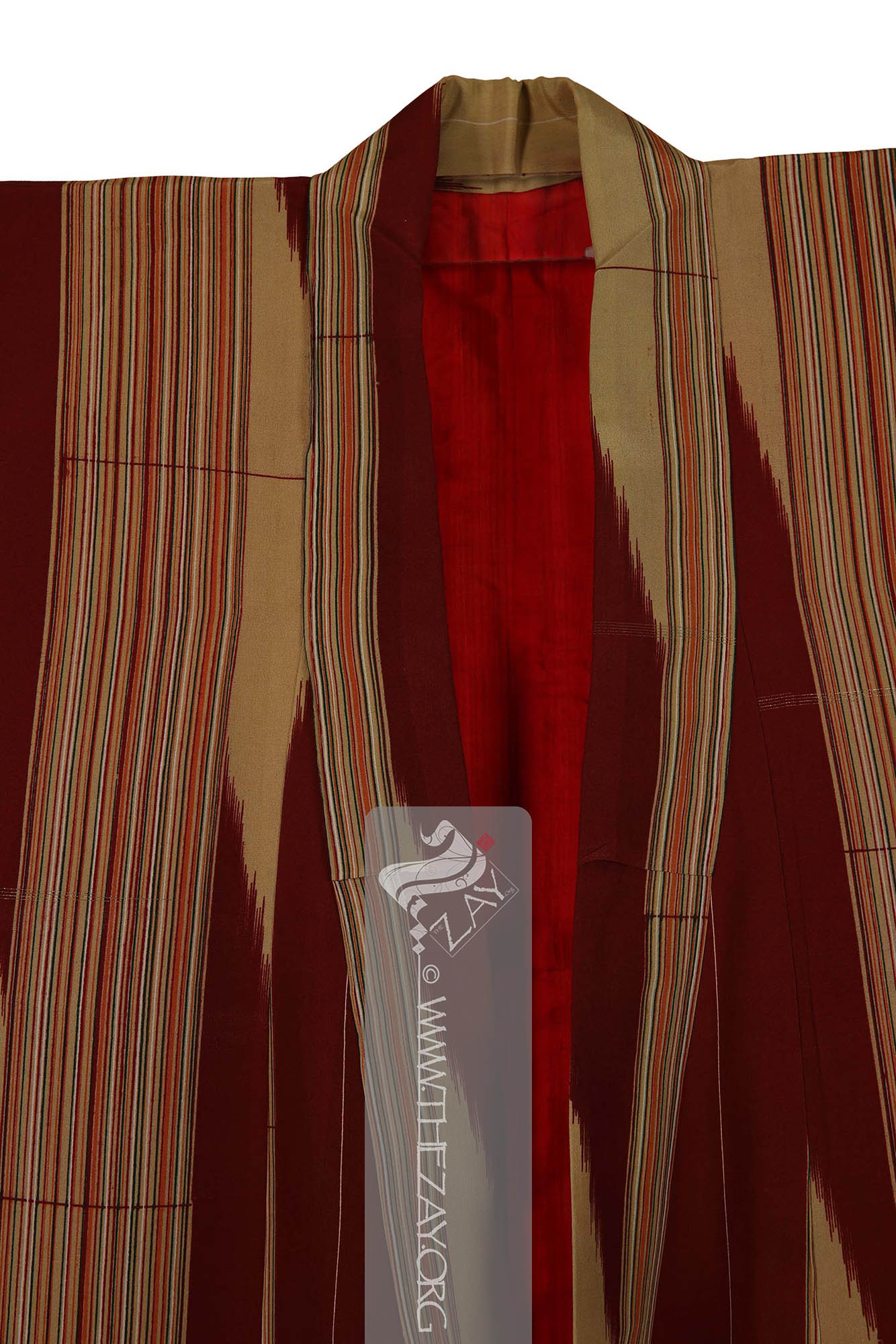Object History This beautiful (
crimson
Crimson: (Persian/Arabic and Turkish: qirmiz or kirmiz – red), is a vivid red color originally made from the dried bodies of a scale insect of the Kermes genus native to the Mediterranean region and was used as a dye for clothing and textiles.) red and beige silk (
houmongi_kimono
Houmongi_kimono: (Japanese: visiting wear), is a type of a semi formal kimono
Kimono: (Japanese: ki : wearing, mono: thing, Singular: Kimono) A traditional Japanese long loose robe with wide sleeves tied with a sash around the waist. Presently it is the national dress of Japan. worn by both married and unmarried women. It is characterised by its elegant colours and painting style design that wraps itself around the wearer. ) was purchased by
Dr. Reem Tariq
Ṭariq: (Arabic; Synonym: tulle_bi_talli
Tūlle_bi_tallī: (French: Tulle – a city in France where fine material for veil was first made; Turkish: tel – wire; Synonym: tariq; talli; badla; khus_dozi ), series of small metal knots made on a woven net ground as embellishment. The term is commonly used in the North African Arab region specifically in Egypt.
; talli; badla; khus_dozi ), series of small metal knots made on a woven net ground as embellishment. The term is commonly used in the Levant Arab region specifically in Lebanon.
El Mutwalli
Dr. Reem Tariq
Ṭariq: (Arabic; Synonym: tulle_bi_talli
Tūlle_bi_tallī: (French: Tulle – a city in France where fine material for veil was first made; Turkish: tel – wire; Synonym: tariq; talli; badla; khus_dozi ), series of small metal knots made on a woven net ground as embellishment. The term is commonly used in the North African Arab region specifically in Egypt.
; talli; badla; khus_dozi ), series of small metal knots made on a woven net ground as embellishment. The term is commonly used in the Levant Arab region specifically in Lebanon.
el Mutwallī: Founder (CEO) of the Zay
Zay: (Arabic: costume, Pl. azyaā’), a set of clothes in a style typical of a particular country or historical period. Initiative, a public figure, speaker and author. An expert curator and consultant in Islamic art and architecture, interior design, historic costume, and UAE heritage. in 2022 from a dealer in New York to enhance the collection of The
Zay
Zay: (Arabic: costume, Pl. azyaā’), a set of clothes in a style typical of a particular country or historical period. Initiative.
Object Features This is a woven silk and (meisen_printed) houmongi_kimono
Houmongi_kimono: (Japanese: visiting wear), is a type of a semi formal kimono
Kimono: (Japanese: ki : wearing, mono: thing, Singular: Kimono) A traditional Japanese long loose robe with wide sleeves tied with a sash around the waist. Presently it is the national dress of Japan. worn by both married and unmarried women. It is characterised by its elegant colours and painting style design that wraps itself around the wearer. with (ikat
Ikat: (Indonesian and Malay: Chord, thread, bundle; Synonym: atlas, adras), is a resist dyeing technique that involves tying and dyeing yarns or threads before weaving, resulting in a distinct pattern. With strong traditions in Southeast Asia, Central Asia, the Indian subcontinent and Central America it probably originated independently around the world. ) style geometric designs primarily in crimson
Crimson: (Persian/Arabic and Turkish: qirmiz or kirmiz – red), is a vivid red color originally made from the dried bodies of a scale insect of the Kermes genus native to the Mediterranean region and was used as a dye for clothing and textiles., green, and ivory on a beige background. The pattern displayed here is very similar to many items in the collection from Syria such as (
ZI2018.500160 SYRIA,
ZI2018.500250 SYRIA, and
ZI2019.500490 SYRIA).
Strict sumptuary laws prohibited Japanese commoners from wearing silk until the 1860s. Therefore, they had to make do with clothing made from rough fabrics woven from hemp or other plant fibers. When the ban on silk was lifted, there was a surge in demand for patterned silk. However, the traditional and expensive
ikat
Ikat: (Indonesian and Malay: Chord, thread, bundle; Synonym: atlas, adras), is a resist dyeing technique that involves tying and dyeing yarns or threads before weaving, resulting in a distinct pattern. With strong traditions in Southeast Asia, Central Asia, the Indian subcontinent and Central America it probably originated independently around the world. dyeing technique became impractical and was replaced with the
meisen_print
Meisen_print: silk fabric patterning technique that involves printing the fabric using a paste resist method. Developed in Japan, the technique uses stencils to apply paste to the warps, creating patterns in bold chemical dyes. The resulting fabric is lightweight, durable, and ideal for informal clothing. technique. This technique involved printing rather than dyeing the fabric, which made it more cost-effective.
In this procedure, a smooth and lightweight silk fabric is patterned using a technique called paste resist dyeing. This method was developed from an earlier technique that involved applying the paste to the (
warp
Warp: One of the two basic components used in weaving which transforms thread or yarns to a piece of fabric. The warp is the set of yarns stretched longitudinally in place on a loom before the weft
Weft: one of the two basic components used in weaving that transforms thread or yarns into a piece of fabric. It is the crosswise thread on a loom that is passed over and under the warp threads. is introduced during the weaving process. )s on a board using stencils and a spatula. Multiple stencils one for each colour were used. This process was faster and also retained the blurred outlines of the traditional
ikat
Ikat: (Indonesian and Malay: Chord, thread, bundle; Synonym: atlas, adras), is a resist dyeing technique that involves tying and dyeing yarns or threads before weaving, resulting in a distinct pattern. With strong traditions in Southeast Asia, Central Asia, the Indian subcontinent and Central America it probably originated independently around the world. technique, which involved binding sections of yarn to resist colour penetration in the dye bath. Despite being relatively quick and inexpensive,
meisen_print
Meisen_print: silk fabric patterning technique that involves printing the fabric using a paste resist method. Developed in Japan, the technique uses stencils to apply paste to the warps, creating patterns in bold chemical dyes. The resulting fabric is lightweight, durable, and ideal for informal clothing. produced an attractive fabric with bright colours that was durable and ideal for regular informal, clothing.
While the origin of certain techniques and methods in textiles like
satin_stitch
Satin_stitch: (Synonym: Damask Stitch), is a type of flat embroidery stitch that creates a satin like smooth and shiny surface by closely spaced stitches, covering an entire area or shape. embroidery can be traced to China, and its spread across the world could be attributed to the Silk Road, other similar techniques and styles are believed to have originated independently in different regions of the world almost simultaneously in human history possibly from necessity and convenience.
Though The
Zay
Zay: (Arabic: costume, Pl. azyaā’), a set of clothes in a style typical of a particular country or historical period. Initiative is concerned mainly with the dress and adornment heritage of the Arab world, it does include in its collection articles from areas outside the region. These tend to be collected to illustrate specific shared elements and influences attesting that the Arab world never existed in a vacuum. It constantly drew, and continues to draw, inspiration and influences from the cultures it comes in contact with be it through trade or geopolitical circumstances, especially those countries within the old silk route.
Therefore, one cannot but draw parallels between many techniques used in such garments, such as (
couching
Couching: (Latin: collocare – Place together), in needlework and embroidery couching is a technique in which yarn or other materials are laid across the surface of the ground fabric and fastened in place with small stitches of the same or a different yarn
) and thread knotting techniques (
macrame
Macrame: makrəˌmā: (Arabic: karam: tree with dangling grapes), ornamental fringe. The art of knotting cord or string in patterns to make decorative articles. Earliest recorded uses of macramé-style knots as decoration appeared in Babylonian and Assyrian carvings.Macrame
Macrame: makrəˌmā: (Arabic: karam: tree with dangling grapes), ornamental fringe. The art of knotting cord or string in patterns to make decorative articles. Earliest recorded uses of macramé-style knots as decoration appeared in Babylonian and Assyrian carvings.: (French: macramé – A hand-knotted textile from Turkish: makrama – table spread or towel, from Arabic: miqrama – bedspread possibly with knotted hanging fringes resembling dangling grapes or karam in Arabic) A form of textile or fringe made by a knotting cord in geometrical patterns possibly originating in Babylon and Assyria.), or flat metal adornment (
talli
Tallī: (Turkish: tel – wire, string), Gulf Arab – a woven braided trimming made with metal wire, threads and ribbons often sewn on detachable panels used as embellishments. Other – (Synonym: tulle_bi_talli
Tūlle_bi_tallī: (French: Tulle – a city in France where fine material for veil was first made; Turkish: tel – wire; Synonym: tariq; talli; badla; khus_dozi ), series of small metal knots made on a woven net ground as embellishment. The term is commonly used in the North African Arab region specifically in Egypt.
; tariq; badla; khus_dozi), series of small metal knots made on a woven net ground as embellishment.
), that are quite similar to those found in different parts of the Arab region.
The
kimono
Kimono: (Japanese: ki : wearing, mono: thing, Singular: Kimono) A traditional Japanese long loose robe with wide sleeves tied with a sash around the waist. Presently it is the national dress of Japan. , in particular, displays similarities that can be drawn with the pattern of Arab women’s overgarment or the (
thawb
Thawb: (Arabic: thawb, Pl. Athwāb/thībān), can be pronounced thobe
Thobe: (Arabic: thawb, Pl. Athwāb/thībān), can be pronounced thawb or tobe
Tobe: (Arabic: thawb, Pl. Athwāb/thībān), can be pronounced thawb or thobe based on locale. The standard Arabic word for ‘fabric’ or ‘garment’. It can refer to a qamīs-like tunic worn by men and women in the Arabian Peninsula, Iraq, the southern and south-western ports and islands of Iran, and some countries in East and West Africa. More specifically, it can refer to the square-shaped Bedouin overgarment worn by women. based on locale. The standard Arabic word for ‘fabric’ or ‘garment’. It can also refer to a qamīs-like tunic worn by men and women in the Arabian Peninsula, Iraq, the southern and south-western ports and islands of Iran, and some countries in East and West Africa. More specifically, it can refer to the square-shaped Bedouin overgarment worn by women. or tobe
Tobe: (Arabic: thawb, Pl. Athwāb/thībān), can be pronounced thawb or thobe based on locale. The standard Arabic word for ‘fabric’ or ‘garment’. It can refer to a qamīs-like tunic worn by men and women in the Arabian Peninsula, Iraq, the southern and south-western ports and islands of Iran, and some countries in East and West Africa. More specifically, it can refer to the square-shaped Bedouin overgarment worn by women. based on locale. The standard Arabic word for ‘fabric’ or ‘garment’. It can also refer to a qamīs-like tunic worn by men and women in the Arabian Peninsula, Iraq, the southern and south-western ports and islands of Iran, and some countries in East and West Africa. More specifically, it can refer to the square-shaped Bedouin overgarment worn by women in the Arabian Gulf region. ), common to the Gulf region, constructed of three uncut panels of broad clothes forming the central body panel and the side sleeve panels very similar in shape to the
kimono
Kimono: (Japanese: ki : wearing, mono: thing, Singular: Kimono) A traditional Japanese long loose robe with wide sleeves tied with a sash around the waist. Presently it is the national dress of Japan. .
Links
- Morishima, Yuki, et al. Kimono
Kimono: (Japanese: ki : wearing, mono: thing, Singular: Kimono) A traditional Japanese long loose robe with wide sleeves tied with a sash around the waist. Presently it is the national dress of Japan. Refashioned: Japan’s Impact on International Fashion. USA, Asian Art Museum, 2018.
- Kahlenberg, Mary Hunt. Asian Costumes and Textiles: From the Bosphorus to Fujiama. Italy, Skira, 2001.
- Liddell, Jill. The Story of the Kimono
Kimono: (Japanese: ki : wearing, mono: thing, Singular: Kimono) A traditional Japanese long loose robe with wide sleeves tied with a sash around the waist. Presently it is the national dress of Japan. . USA, E P Dutton, 1989.
- Dalby, Liza Crihfield. Kimono
Kimono: (Japanese: ki : wearing, mono: thing, Singular: Kimono) A traditional Japanese long loose robe with wide sleeves tied with a sash around the waist. Presently it is the national dress of Japan. : Fashioning Culture. Reaktion Books, 1993.
- Gluckman, Dale Carolyn and Sharon Sadako Takeda. When Art Became Fashion: Kosode
Kosode: (Japanese: small sleeve or opening), a traditional Japanese inner robe for both genders. Similar to a kimono but with a wider body, longer collars, and narrower and rounded sleeves, often stitched to the body, these under robes were lavishly decorated and were worn on top from late 16th century. in Edo-Period Japan. Los Angeles County Museum of Art, 1996.
- Kimono
Kimono: (Japanese: ki : wearing, mono: thing, Singular: Kimono) A traditional Japanese long loose robe with wide sleeves tied with a sash around the waist. Presently it is the national dress of Japan. : Kyoto to Catwalk. 27 Aug. – 25 Oct. 2020, V&A South Kensington, London https://www.vam.ac.uk/exhibitions/kimono
Kimono: (Japanese: ki : wearing, mono: thing, Singular: Kimono) A traditional Japanese long loose robe with wide sleeves tied with a sash around the waist. Presently it is the national dress of Japan. -kyoto-to-catwalk
- Gluckman, Dale Carolyn. “Liza Dalby. Kimono
Kimono: (Japanese: ki : wearing, mono: thing, Singular: Kimono) A traditional Japanese long loose robe with wide sleeves tied with a sash around the waist. Presently it is the national dress of Japan. : Fashioning Culture.:Kimono
Kimono: (Japanese: ki : wearing, mono: thing, Singular: Kimono) A traditional Japanese long loose robe with wide sleeves tied with a sash around the waist. Presently it is the national dress of Japan. : Fashioning Culture.” Museum Anthropology, vol. 19, no. 1, Mar. 1995, pp. 79–81. Crossref, https://doi.org/10.1525/mua.1995.19.1.79
- “Meisen Kimono
Kimono: (Japanese: ki : wearing, mono: thing, Singular: Kimono) A traditional Japanese long loose robe with wide sleeves tied with a sash around the waist. Presently it is the national dress of Japan. From HALI 184 - HALI.” HALI, 24 July 2015, hali.com/news/meisen-kimono
Kimono: (Japanese: ki : wearing, mono: thing, Singular: Kimono) A traditional Japanese long loose robe with wide sleeves tied with a sash around the waist. Presently it is the national dress of Japan. .
- Kimono
Kimono: (Japanese: ki : wearing, mono: thing, Singular: Kimono) A traditional Japanese long loose robe with wide sleeves tied with a sash around the waist. Presently it is the national dress of Japan. Style: Edo Traditions to Modern Design: The John C. Weber Collection. USA, Met Publications, www.metmuseum.org/art/metpublications/Kimono_Style
- Richard, Naomi Noble. “Nō Motifs in the Decoration of a Mid-Edo Period Kosode
Kosode: (Japanese: small sleeve or opening), a traditional Japanese inner robe for both genders. Similar to a kimono but with a wider body, longer collars, and narrower and rounded sleeves, often stitched to the body, these under robes were lavishly decorated and were worn on top from late 16th century. .” Metropolitan Museum Journal, vol. 25, 1990, pp. 175–83. JSTOR, https://doi.org/10.2307/1512899. Accessed 10 May 2023.
- Kramer, Elizabeth. “Review of ‘Kimono
Kimono: (Japanese: ki : wearing, mono: thing, Singular: Kimono) A traditional Japanese long loose robe with wide sleeves tied with a sash around the waist. Presently it is the national dress of Japan. : A Modern History.’” Reviews in History, School of Advanced Study, 2015. Crossref, https://doi.org/10.14296/rih/2014/1787.




